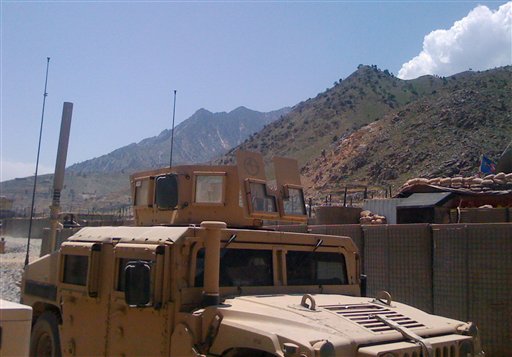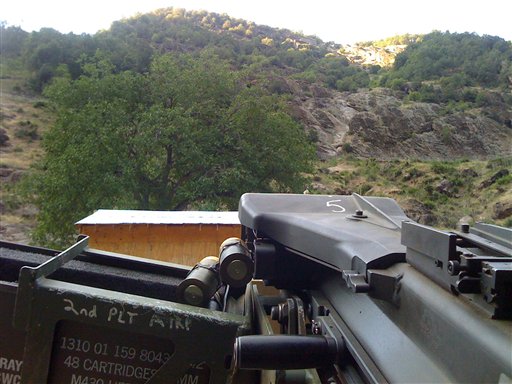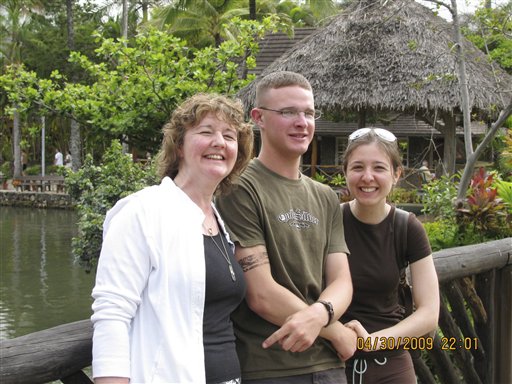Gareth Porter writing for the Asia Times discusses an unpublished paper written by Lt. Col. Daniel L. Davis currently making its way around Washington. Rather than focus on what Porter says Davis says, we’ll briefly spend some time on the alternative Davis offers.
His paper is entitled Go Big or Go Deep: An Analysis of Strategy Options on Afghanistan. Davis’ first problem is that U.S. troops (and ISAF) are seen as “invaders” or “occupation forces.” Our troops have been there for eight years and are likely to be there many more under this plan, and this potential downfall of the campaign has not been given its due in the deliberations to date.
His second problem with the go big option is that the requested troop levels (on the order of 40,000) is not nearly enough. He continues cataloging his objections including (but not limited to) the fact that logistics will be difficult for more troops, the government is corrupt, and the startup of ANA forces has been more difficult than has been expected (and likely will not be sustainable by the Afghan economy).
Davis then begins his “go deep” alternative.
“Go Deep” is a comprehensive and pervasive strategy that incorporates critical components of the intelligence community, special operations forces, conventional military forces, military Advise and Assist units, governmental assistance and development, provides economic advisors, features educational development, and other elements of national power that are synthesized to form a unified, two-track objective: to 1) conduct an aggressive counterterrorist effort associated with 2) robust, focused support to indigenous governmental and military forces. Far from representing a “retreat” from Afghanistan, it “goes deep” into numerous elements of the region.
In its most basic form, Go Deep seeks to simultaneously build and strengthen the Afghan government, help develop its economy, place an increased emphasis on drastically increasing literacy rates through targeted education programs, and invest in the development of its armed forces while simultaneously conducting an aggressive regional counterterrorist campaign. This plan completely agrees with the majority of opinion-leaders that we cannot abandon Afghanistan. Where it differs, however, is in which levers of national power we should use to give us the best chance of achieving national policy objectives.
For reasons outlined throughout this paper, I believe that Go Big uses the wrong instruments and could unintentionally make our situation worse, while Go Deep uses a more nuanced approach – but one that is aggressive in its intent to attack and destroy America’s enemies while being equally aggressive in its support of America’s friends.
He continues with his vision for the campaign.
Far too often the advocates of Go Big deride anything as a minimalist approach which “relies on drones and missile attacks from off shore.” In fact, Go Deep – while exploiting all the capabilities resident in both the striking and ISR (intelligence, security, and reconnaissance) features of unmanned aerial vehicles (UAV) – relies on a full range of capabilities resident in the United States Department of Defense and Central Command.
We will use covert agents, in conjunction and association with locals to develop (and expand) human intelligence resources that help to identify the Taliban and other insurgent leaders from the non-insurgent people – no easy task. We will indeed make extensive use of unmanned aerial vehicles for intelligence and reconnaissance as well as Predator missile attacks once the enemy is positively identified. We will continue to exploit all technical means of tracking them, to include cell phone intercepts, satellite imagery, and other tools of the intelligence world.
Davis then makes several observations concerning detractors of his strategy.
One of the biggest fears voiced by many adherents of the Go Big theory is that if the US Military withdraws, the Taliban will overcome the ANSF and take Kabul. But the Go Deep concept does not envision the complete withdrawal of American and NATO military forces. Go Deep recognizes that the training of the ANSF continues to be an important component of an eventual strategy resulting in the complete withdrawal of American military forces from Afghanistan. In the near term, however, the plan would be to set an 18 month time frame during which the bulk of American and NATO combat forces would be withdrawn from the country. Concurrent we would focus on training the ANSF to continue deepening and broadening their abilities. But I recommend that we limit the number of Afghan National Security Forces to the numbers approved by the September 10, 2008, Joint Coordination and Monitoring Board (JCMB): 134,000 members of the ANA and 80,000 members of the ANP …
Meanwhile, the United States and/or NATO would establish a base of Special Operation Forces which would continue working with the ANSF throughout the country to continue developing Human Intelligence sources by which kinetic operations against irreconcilable or unrepentant insurgent and/or terrorist forces would be identified, targeted, and killed or captured.
Davis mentions troop exhaustion as an ongoing and increasing problem, and finally mentions his view of the objection that the counterterrorism approach he advocates might lead to a resurgent Taliban who would again give safe haven to al Qaeda.
Would the Taliban, then, open those same doors in areas they may control in the future? That outcome is anything but certain. In the October 5th Newsweek article previously cited it is instructive how the Afghan Taliban members now refer to Arab al Qaeda. An insurgent named Maulvi Mohammad Haqqani said of al Qaeda: “We gave those camels [a derogatory Afghan term for Arabs] free run of our country, and they brought us face to face with disaster.” While the Taliban certainly have no love for the United States, neither do they feel any sense of obligation to paying for an al-Qaeda launching pad with their blood. They described in excruciating detail the horror they experienced and the slaughter they suffered from American attacks in October 2001 when they ruled the country.
Analysis & Commentary
Davis’ analysis is remarkable for its contradiction and also for his disbelief of his own views. On the one hand, it’s not likely under his plan that the Taliban would return to power with the slightly smaller but more well trained Afghan National Army along with SOF performing counterterrorist HVT strikes – or so he claims. On the other hand, he feels that is is necessary to address the objection that a return to Taliban control would mean a return to safe haven for al Qaeda. But if it’s true that his plan would prevent a return to Taliban control, and also if it’s true that occupying forces give the Taliban their currency (and without us they wouldn’t have a raison d’être), then it shouldn’t be necessary to predict what would happen if the Taliban returned to power.
On the one hand the corrupt ANA and ANP are one of the biggest problems (and to be fair, our own coverage of ANA and ANP has been unforgiving, but still truthful). On the other hand, reliance on them along with some HVT strikes by SOF is the cornerstone of his plan.
On the one hand logistics is a problem for more troops (and again, see our own coverage of logistics for Afghanistan which has, to our knowledge, been unmatched). On the other hand, a small footprint with a corrupt ANA and ANP and possible return to Taliban control over the countryside apparently doesn’t impress Davis as leading to intractable logistics problems with the SOF we leave in Afghanistan.
On the one hand, Davis wants SOF performing HVT raids to take out big actors based on robust intelligence. On the other hand, leaving the countryside to Taliban control doesn’t impress Davis as being a problem for this intelligence after collaborators are beheaded.
On the one hand, Davis observes that we don’t have enough troops to secure Afghanistan, noting the large scale engagements such as the battle of Wanat (see our own article on battles in Nuristan and Wanat in the context of massing of enemy troops). On the other hand, a smaller ANA and fewer U.S. troops are somehow superior to what we now have and would be able to hold the terrain.
On the one hand, more U.S. troops to secure the population and kill the insurgents would be seen as an occupying force, turning the Afghan population against them. On the other hand, SOF operators who do not protect the population but who come and kill their family members in the middle of the night are somehow acceptable to the population.
The fact of the matter is that recent Marine Corps operations in Helmand found that they were in the beginning stages of gaining the human intelligence necessary to find and weed out the enemy, but also that fear of retribution is everywhere. Security is paramount to the Afghans, even above schools and other assistance. While the typical counterinsurgency tactics of population engagement and nonkinetic operations have been employed, the locals want us to chase and kill the Taliban.
It’s understandable that an alternative to a long term effort is being sought in Afghanistan. These are happy thoughts, to be sure. Pristine intelligence, dedicated truck drivers for logistical supplies, a highly trained and smaller ANA which can do the job of 400,000 – 500,000 combined troops, drones which give reliable information that never leads to killing noncombatants, fuel for the drones, safe SOF operators who can launch raids out of their protected FOBs, CIA operatives throwing around satchels of cash to get tips, a willing Afghan population, and so on the dream goes.
But the reality of the situation is that there are even now foreign fighters in Afghanistan, and the rejection of al Qaeda by Haqqani means nothing to the new head of the TTP, Hakimullah Mehsud, who views al Qaeda with love and affection, or to Mullah Omar who views UBL with admiration, respect and love.
The reality of the situation is that collaborators would be beheaded in short order. The reality of the situation is that truck drivers who now practice strap hanging to U.S. convoys would all be blown up and killed. The reality of the situation is that the Taliban would indeed return to power, and that al Qaeda swims in these waters.
The reality of the situation is that going deep is not an option, but rather, a daydream. “Going deep” is a nicely packaged strategy for failure. There is going big or going home. Both of these are viable options. Davis does raise an important moral dilemma when he discusses the condition of the troops who are repeatedly asked to deploy. But Davis is ignoring a huge gold mine of resources. As I have pointed out before, I have not in four years seen the density of Marines aboard Camp Lejeune that I do now. The Marines are no longer in Anbar. They are one of three places. Camp Lejeune, Camp Pendleton, or aboard amphibious assault docks wasting time and money as forces in readiness. Sure, there are some at other places such as Twenty Nine Palms, Marine Corps Air Station at Cherry Point, and so on. But the bulk of Marines are located in the states. While the Commandant has visions of wasteful spending on Expeditionary Fighting Vehicles and catastrophic amphibious assaults against unknown stable-state enemies, the campaign suffers in Afghanistan awaiting forces. The Marines can and should answer the call.
But if the forces are there to conduct the campaign, Davis’ point remains salient. Committed leadership is needed, not vacillating questions and demurrals. And if leadership is committed, the nation can be brought along. If the nation is brought along, the troops necessary to get the job done can and will be deployed. This will mean an increase in the size of both the Army and Marines, and out of the several trillion dollars Timothy Geithner has printed over the last nine months, some must be found for the military.
Prior and recently related:
Can an Insurgency (and Counterinsurgency) Remain Static?
The Slow Fall of Kandahar
What Kind of Counterinsurgency for Afghanistan?
Counterinsurgency v. Counterterrorism
Why are we in the Helmand Province?
Discerning the way forward in Afghanistan
Afghanistan: What is the Strategy?
A Return to Offshore Balancing






